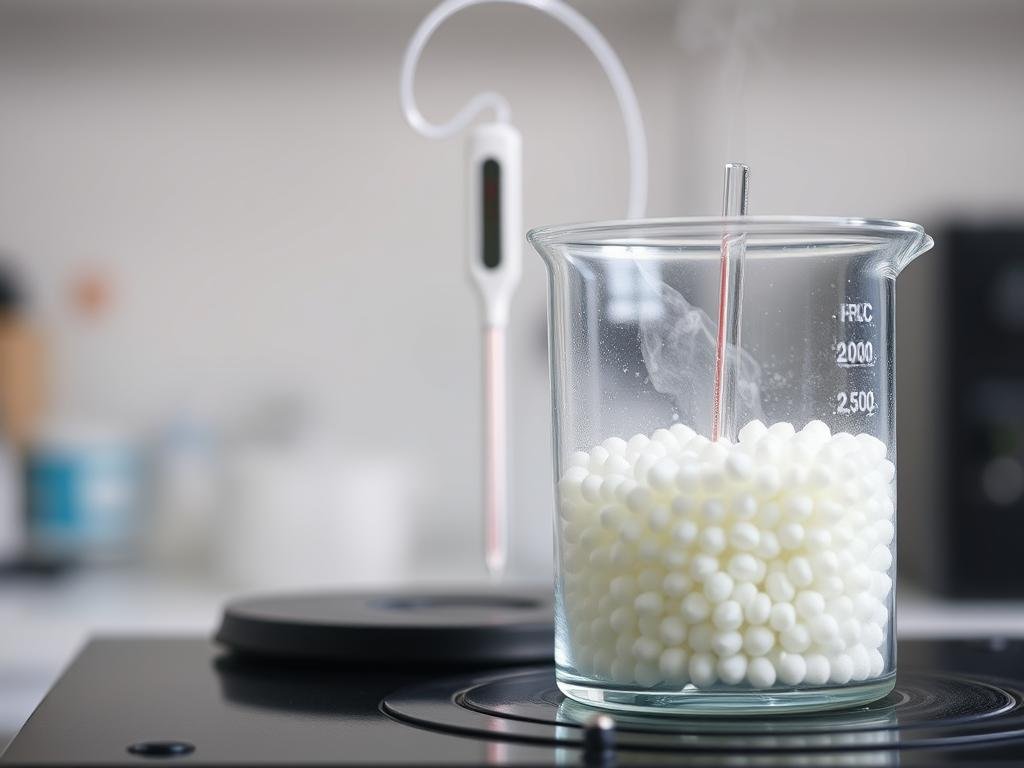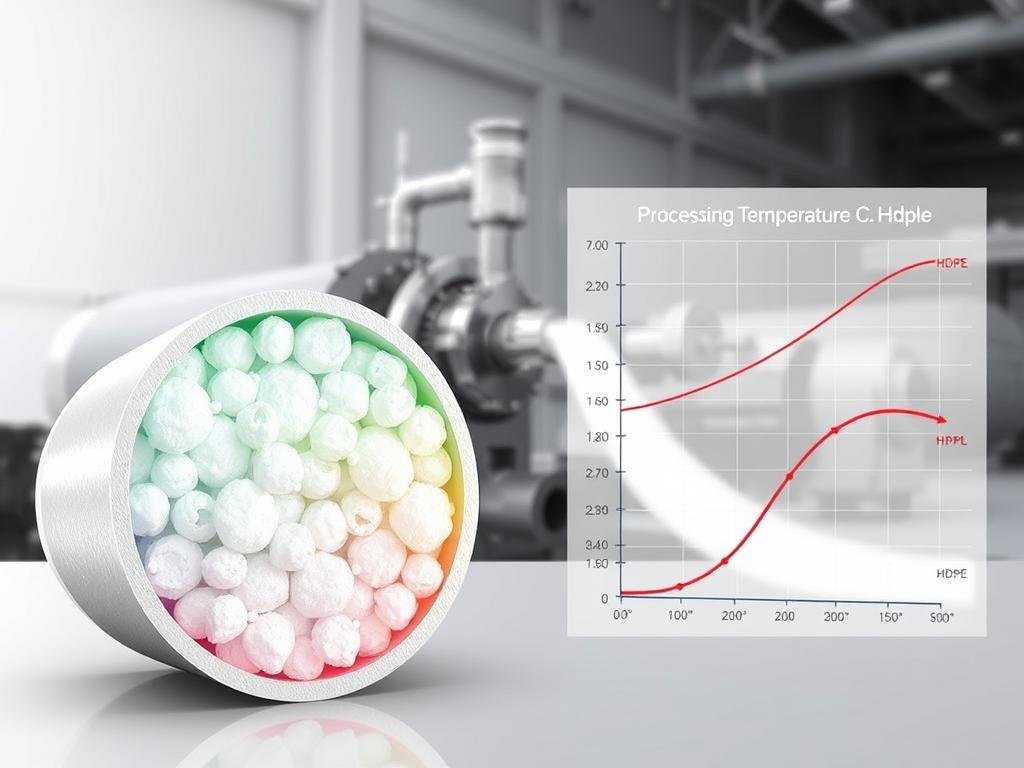Polyéthylène haute densité (PEHD) est un matériau plastique polyvalent connu pour sa haute cristallinité et ses propriétés thermiques uniques. La point de fusion de PEHD, généralement autour de 135 °C (275 °F), est une caractéristique essentielle qui influence ses applications.
The temperature at which HDPE transitions from a solid to a liquid state is significant for both processing and end-use applications. Understanding this property is essential for manufacturers and engineers working with HDPE.
HDPE’s molecular structure, characterized by a low proportion of side branching groups, contributes to its thermal properties, making it a valuable material across multiple industries.
Understanding High-Density Polyethylene (HDPE)
With its high density and specific molecular arrangement, HDPE exhibits a range of characteristics that make it highly valuable in various applications. Its unique structure grants it superior propriétés that are not commonly found in other types of polyethylene.
Ce qui distingue le PEHD
HDPE is distinct from other polyethylenes due to its high density and minimal branching, which results in stronger intermolecular forces. This characteristic enhances its force et résistance to various environmental factors.
Key Physical Properties
HDPE boasts several key physical properties that contribute to its widespread use. Some of its notable attributes include:
- High tensile force (15.2-45 MPa), ideal for load-bearing applications.
- Outstanding chemical résistance, en particulier aux acides et aux bases.
- Une dureté Shore D de 55-69, offrant une bonne rigidité et résistance aux chocs résistance.
- Low water absorption rate, contributing to its dimensional stability.
| Propriété | Valeur | Avantage |
|---|---|---|
| Résistance à la traction | 15.2-45 MPa | Capacité de charge |
| Résistance chimique | Haut | Durable in harsh environments |
| Dureté Shore D | 55-69 | Rigidity and impact resistance |
The combination of these properties makes HDPE a versatile matériel with excellent performance dans une large gamme d'applications, des systèmes de tuyauterie aux matériaux d'emballage.
The HDPE Melting Point: A Closer Look
To fully leverage HDPE’s potential, it’s necessary to examine its melting point in detail. The melting point is a critical property that determines the suitability of HDPE for various applications.
Typical Melting Range: 120°C to 180°C
The melting point of HDPE typically ranges between 120°C to 180°C. This range is influenced by the material’s molecular structure and crystallinity. The specific melting point within this range can vary based on the HDPE grade and production process.
| Propriété | Typical Value | Unité |
|---|---|---|
| Melting Point Range | 120 – 180 | °C |
| Crystallinity | 60 – 80 | % |
| Molecular Weight | Varied | g/mol |
Comment la température de fusion est mesurée
Le point de fusion du PEHD est généralement mesuré à l'aide de la calorimétrie différentielle à balayage (DSC), une technique d'analyse thermique qui suit le flux de chaleur lors des transitions de phase. 
- DSC testing involves heating a small sample of HDPE at a controlled rate alongside a reference material, and recording the difference in heat flow.
- Le point de fusion est identifié sur le thermogramme résultant comme un pic endothermique, représentant la température à laquelle les régions cristallines du polymère absorbent de la chaleur pour passer de l'état solide à l'état liquide.
- Standardized test methods, such as ASTM D3418, are used to ensure accurate and consistent measurement of the melting point.
This precise measurement is essential for quality control in manufacturing and for ensuring that HDPE materials meet specific thermal performance requirements.
Factors Affecting HDPE’s Thermal Properties
Understanding the factors that affect HDPE’s thermal properties is essential for optimizing its performance in various applications. Several factors play a crucial role in determining HDPE’s thermal behavior.
Molecular Weight and Structure
The molecular weight and structure of HDPE significantly influence its melting point and thermal stability. Higher molecular weight HDPE tends to have a higher melting point due to its larger molecular size and stronger intermolecular forces.
Crystallinity and Its Impact
Crystallinity is another critical factor affecting HDPE’s thermal properties. Higher crystallinity levels result in a higher melting point because the crystalline regions are more stable and require more energy to melt.
Additives and Their Effects
La présence de additives, such as antioxidants and stabilizers, can slightly alter the melting point of HDPE. These additives can enhance performance ou apparence mais peut affecter le température at which the plastic melts. Various additives can influence HDPE’s melting behavior and overall thermal properties.
Traitement du PEHD : Considérations de température
Lors du traitement du PEHD, la température joue un rôle crucial dans la détermination de la qualité du produit final. Les propriétés thermiques du PEHD influencent de manière significative son traitement et ses performances dans diverses applications.
Exigences de température pour le moulage par injection
L'injection de HDPE nécessite un contrôle précis de la température. La plage de température pour l'injection varie généralement, mais il est essentiel de maintenir une température constante pour garantir la qualité du produit final. Contrôle optimal de la température aide à atteindre les propriétés souhaitées du PEHD.
Extrusion et autres procédés de fabrication
L'extrusion est une autre méthode courante pour le traitement du PEHD, en particulier pour la fabrication de bouteilles et de contenants. Le processus consiste à chauffer le PEHD à environ 150°C à 160°C, le rendant malléable. Différents processus de fabrication ont des exigences de température différentes.
| Process de fabrication | Plage de température (°C) | Plage de température (°F) |
|---|---|---|
| Extrusion | 150-220 | 302-428 |
| Thermoformage | 130-150 | 266-302 |
| Moulage par rotation | (Températures du four) 149-343 | (Températures du four) 300-650 |

Applications exploitant la résistance à la chaleur du PEHD
La résistance à la chaleur du PEHD en fait un matériau polyvalent pour diverses applications. Sa capacité à supporter des températures élevées sans compromettre son intégrité structurelle est essentielle dans plusieurs industries.
Systèmes de construction et de tuyauterie
In construction and piping systems, HDPE is valued for its thermal stability and resistance to chemicals. It is used in piping for hot water distribution and industrial effluent handling. The material’s durability and resistance to corrosion make it an ideal choice for these applications.
Applications de l'industrie de l'emballage
The packaging industry benefits from HDPE’s heat resistance, particularly in the production of containers and bottles that can withstand hot filling processes. Résistance chimique du PEHD assure également que le matériau d'emballage ne réagit pas avec le contenu, en maintenant l'intégrité du produit.
Automotive and Industrial Uses
In the automotive sector, HDPE is used for manufacturing fuel tanks, fluid reservoirs, and other components that are exposed to high temperatures. Industrial equipment also incorporates HDPE parts due to their heat resistance and chemical stability. Examples include Pare-chocs en PEHD, HDPE Dashboard Components, et HDPE Fuel Tanks. The material’s ability to maintain dimensional stability and mechanical properties under varying temperatures makes it suitable for these demanding applications.
- Automotive applications of HDPE include parts that must withstand elevated temperatures, such as fuel tanks and under-hood components.
- Les équipements industriels utilisent des composants en PEHD dans les zones nécessitant à la fois une résistance à la chaleur et aux produits chimiques.
Conclusion: Why HDPE’s Melting Point Matters
The melting point of HDPE is a critical factor that influences its processing and end-use performance. Knowing this property is essential for determining the appropriate processing temperature, application suitability, and recyclability. Effective material selection relies on understanding HDPE’s thermal behavior. Its relatively high melting point makes HDPE a versatile material for various applications, from construction to packaging. As sustainability concerns grow, HDPE’s recyclability positions it as an environmentally responsible choice. By understanding HDPE’s melting point, engineers and designers can make informed decisions, driving innovation in product design and manufacturing techniques.
